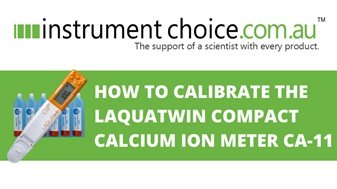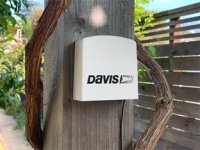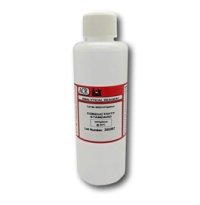How to Calibrate the LAQUAtwin Compact Calcium Ion Meter (CA-11)

Calibration is essential if you require accurate and reproducible results. So you can have easy to follow information at your fingertips, the Instrument Choice scientists regularly demonstrate how to calibrate some of our most popular products.
In this edition, you can learn how to calibrate the LAQUAtwin Compact Calcium Ion Meter and check out our scientists' helpful troubleshooting tips.
Figure 1 Watch an Instrument Choice scientist calibrate the LAQUAtwin compact calcium ion meter here.
How to Calibrate the LAQUAtwin Compact Calcium Ion Meter (CA-11)
Materials
You will need;
- The LAQUAtwin Compact Calcium Ion Meter (CA-11)
- 150ppm standard calibration solution
- 2000ppm standard calibration solution
- Tap water
Calibration
- Switch the meter on by pressing the ON/OFF key.
- The first point of calibration on this meter will default to 150ppm, and the second point is 2000ppm. Open the sensor head and apply enough 150ppm solution to cover the sensor.
- Close the lid.
- Press the CAL button. CAL and the first default solution of 150ppm will blink on the screen.
- Press CAL again. The current measurement, CAL and the status indicator smiley face will now blink on the screen. Wait as the unit calibrates.
- When calibration is complete, the CAL indicator will stop blinking, and the stability indicator smiley face will remain on the screen for a few seconds before returning to measurement mode. The first point of calibration is complete.
- Remove the buffer solution and rinse the sensor in tap water. If needed, dry the sensor using soft, lint-free tissue. The sensor is glass, so perform this with extreme care.
- Next, perform calibration to 2000ppm. Open the sensor cover.
- Apply enough 2000ppm solution to cover the sensor.
- Press CAL.
- CAL and the second solution (2000ppm) will blink on the screen.
- Press CAL again and the current measurement, CAL and the status indicator smiley face will blink on the LCD.
- When calibration is complete, the CAL indicator will stop blinking, and the stability indicator smiley face will remain on the screen for a few seconds before returning to measurement mode.
- Two-point calibration is complete. Remove the buffer solution and rinse the sensor before use.
Troubleshooting Tips
If you are using the correct standard solutions to calibrate your meter and are still having difficulty calibrating it, here are two things you can do to troubleshoot:
- Check the Sensor. Your sensor must be clean, undamaged and clear of debris. Its best practice to clean your sensor with water after each use. If the sensor is exceptionally dirty (i.e. was not cleaned after use, has built up grime or has been unused for an extended period) clean the electrode well with electrode cleaning solution.
- Reset the Unit. If you know your sensor is clean, undamaged, and yet errors are still occurring when you perform a calibration, try resetting the CA-11. Here’s the procedure:
- Start with the meter off.
- Press and hold all three buttons on the CA-11’s panel until the LCD switches on (around 3 seconds).
- Release all three buttons again when the LCD switches on. The software version will display first followed by the display of "Int".
- When "Int" is displayed, press the CAL button. The screen will display "End" then switch off.
- Reset is complete. Return to calibration step 1 [EM-IC2]and try calibrating your unit again.
Conclusion
Performing calibration at regular intervals is crucial for every professional or home user who wants to ensure consistently accurate results. This process is straightforward using the LAQUAtwin Compact Calcium Ion Meter (CA-11).
Need a hand calibrating or want more information about the CA-11? See the links below or contact us!
Additional links
- View the LAQUAtwin Compact Calcium Ion Meter (CA-11) here
- Watch How to Calibrate the LAQUAtwin Compact Calcium Ion Meter (CA-11) again
- Watch an Instrument Choice scientist perform a calibration reset here.
- View replacement LAQUAtwin Compact Calcium Ion sensors
- New units come with a 14mL bottle of 150 and 2000ppm calcium ion solution. You can purchase replacement calibration solutions here:
- Get electrode cleaning solution here

Also interesting
Davis Instruments, a company renowned for their durable, precise and accurate weather stations and environmental monitoring equipment, has recently launched a new, featureful and versatile AirLink Air Quality Sensor.
Your Instrument Choice team has just completed a comprehensive review, and the news is they're very impressed – the Davis Instruments AirLink Air Quality Sensor is great! The AirLink Air Quality Sensor meets Davis Instruments' ethos and high standards.

Calibration using pre-prepared standard solutions is essential if you require accurate and reproducible results using a conductivity meter. Potassium Chloride (KCl) is the most popular calibration solution. This article reveals why KCl is so popular, provides calibration tips and examples of the biggest selling pre-mixed products.

